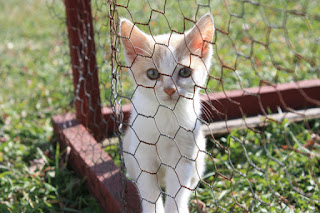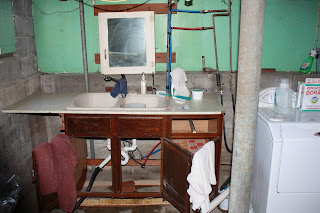A common question that the farmers get every year is "what are you growing that is new?" Apparently, the late Winter has delayed that question and I was asked for the first time in 2018 just this past week. I was caught totally unprepared to answer that question because I think my brain's schedule says the time is past to talk about it.
 |
| St Valery carrots |
While I am not going to list every variety that we will be growing this year, I'll feature a few vegetable types. And, I can tell you that we grow between 30 and 40 different vegetable types and we typically order about 250-350 different seed varieties every year.
Tomatoes
We have the most variety in our heirloom/heritage tomato cultivars, so that is usually the place to start. We did removed John Baer and Emmy from the grow list. Neither has distinguished themselves over the past couple of years and we have other varieties with similar characteristics that have performed better on our farm. We are adding Indigo Rose (Tammy's choice), which is not an heirloom variety, but it is an open-pollinated new introduction that is supposed to be high in anti-oxidants and will exhibit a very dark coloration in hot temperatures. We'll give a few plants a trial in one of the high tunnels and see how they produce (and, more important, how they taste).
 |
| Dr. Wyche's Yellow |
We were a little unhappy to discover that somehow, as we were seeding the tomatoes, the Tasty Evergreens did not get planted. Rob may still put a couple of seeds in a tray to see if he can get a Fall treat or two off of a plant. Usually, we don't get all that many tomatoes from them anyway, so most people will not notice. But, the farmers certainly will.
Otherwise, our traditional favorites will be there. Italian Heirloom, German Pink and Dr. Wyche's Yellow continue to do most of the larger tomato production. Black Krim and Paul Robeson will provide the tasty 'black' tomatoes again this year. Our snack tomato lineup of Jaune Flamme, Green Zebra, Red Zebra and Wapsipinicon Peach will be supplemented by Indigo Rose and the return of Stupice (a very early red tomato).
Lettuce
 |
| Bunte Forellenschus |
Once again, we have our favorites, such as Grandpa Admires, Crispmint, Bronze Arrowhead and Bunte Forellenschus. They will, of course, all return to the farm this year. On the other hand, we haven't really been happy with Rouge d'Hiver, so it has been falling off our grow list slowly the past few years. Amish Deer Tongue and Australian Yellow Leaf are only scheduled for one iteration since they seem to have very specific situations where they excel.
On the other hand, we are doing another Summer Lettuce Trial with PFI this year and we will see Magenta, Nevada, Concept and Winter Density in that trial. Yes, Winter Density does not seem like a good Summer trial candidate. But, we're growing it in part because it will show how a variety that is not rated to handle heat responds as compared to the other lettuces.
Onions
We have been very happy with White Wing and have already put in a full 200 foot bed of those for this year's production. Redwing has also been a favorite and those are also in the ground at this time. Sedona is the storage yellow that we have used for the past three years with success, but we are also extending our trial of New York Early to see if we can identify an open-pollinated yellow storing onion. Gladstone will serve the same purpose for the open-pollinated white. And, of course, we can't have a season where we do not grow Aisla Craig Exhibition as our sweet yellow onion.
 |
| Snow Crown |
At present, the plan is to increase our onion production assuming we can get them all in at a reasonable point in time this May. We feel like this is one crop we can manage to scale up without causing issues with resources, our rotation and our intercropping mix.
Broccoli and Cauliflower
Not much new to report here except that we will bring Imperial back for the "head to head" broccoli trial one more time with Belstar and Gypsy. Cauliflower will continue to be a mix of Goodman, Amazing and Snow Crown. Perhaps, one day, we'll feel as if we trust Goodman and Amazing enough (both open-pollinated) that we'll drop the F1 Hybrid (Snow Crown). This year is not that year.
Melons
Pride of Wisconsin and Minnesota Midget will continue to anchor melon production with Pride in the field and Midget in the high tunnels. Once again, Eden's Gem and Emerald Gem should help with early melon production. We're hoping to encourage Ha'Ogen by growing an F1 Hybrid (Arava) as competition. Arava will be the first non-heirloom melon we have grown on the farm. There are numerous reasons for this trial, but this is probably not the place to enumerate them. Regardless, Arava is supposed to be similar in style and flavor to Ha'Ogen.
We no longer grow Boule d'Or, but we will continue to give space to Oka and Hearts of Gold. We're looking forward to a great melon year.
 |
| Winner |
Kohlrabi
We have relied on Kolibri for our purple kohlrabi and Winner as our white kohlrabi for many years now. Unfortunately, Winner is no longer available - thus the dangers of F1 Hybrid seed varieties for farmers such as ourselves is reconfirmed. There were two new (to us) white kohlrabi's being offered, so we thought we would try some of each. Kordial and Lech will be given every chance to succeed since we don't have many other options.
For those who are curious, there are not many open-pollinated kohlrabi options out there.
New to Newish
Other varieties that are new to us this year or were new last year are the sorts of things we try when we are looking for a particular quality. For example, Keira is a basil that is supposed to be cold tolerant. We are hoping to see if we can extend basil in the fall a bit to go with our late Fall tomatoes. Arcadia is a broccoli that is also supposed to be very cold tolerant, so we are going to see if we can mature some broccoli for November harvest in the high tunnel. And, Westlander kale provides stems that are very heavily ruffled with a lot of substance. Of these, we have tried Westlander and not the others.
Also newish to the farm are Silver Slicer cucumber, Blacktail Mountain watermelon and Danvers 126 carrots. If any of these exceed expectations, you'll be certain to hear about it here.
Hoping for Rebound

There are always a few varieties that seem to disappear from the customer's perspective due to various issues every season. A year after getting rave reviews for Gold of Bacau romano style beans, we were unable to harvest any in 2017. It was simply a matter of timing and available labor at the point they matured. When the resources don't line up, something has to give. Last year, it was pole beans.
And, the watermelons were pretty much shut out in 2017 as well. The spray drift incident finished off any remaining hope for a stray watermelon last year, but that crop was already pretty much lost due to weed pressure and poor field conditions. As you might guess, it started with the latter, which led to the former.
Good-bye, Maybe Next Year?
 |
| Dunja |
There are some cultivars that will not return to the farm in 2018 beyond the aforementioned John Baer and Emmy. Raven, Midnight Lightning and Golden zucchini are all going to be removed from our grow list for 2018. Dunja has outperformed Raven as the F1-hybrid main crop zucchini for our farm and the seed supply has become less reliable, so it makes sense for it to be removed. Golden is a finicky grower and our customers do not seem to be terribly enamored with it. Midnight Lightning, on the other hand, is a disappointment to us. It is an open-pollinated zucchini developed by High Mowing. It's first year of production was very good, but it has declined in quality since that time.
Sunburst Patty Pan's production has gone down and people do not seem to be as happy with them as they once were. Perhaps times will change and they will return, but not this year. Table Queen acorn squash simply doesn't have the taste that Thelma Sanders (tan acorn squash) does and we think we can promote Thelma Sanders enough to make Table Queen's absence go unnoticed. And, Jupiter bell peppers won't be on the grow list because seed arrived to late for us to start for this season.
And there you are - a detailed answer to the question. We hope you enjoyed it.





















































